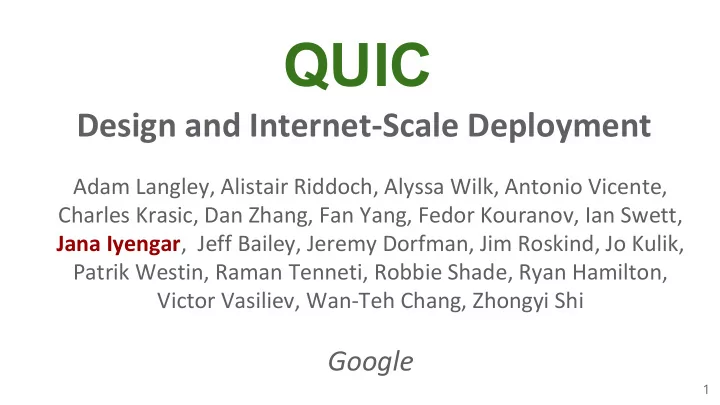

QUIC Design and Internet-Scale Deployment Adam Langley, Alistair Riddoch, Alyssa Wilk, Antonio Vicente, Charles Krasic, Dan Zhang, Fan Yang, Fedor Kouranov, Ian Swett, Jana Iyengar , Jeff Bailey, Jeremy Dorfman, Jim Roskind, Jo Kulik, Patrik Westin, Raman Tenneti, Robbie Shade, Ryan Hamilton, Victor Vasiliev, Wan-Teh Chang, Zhongyi Shi Google 1
A QUIC history Protocol for HTTPS transport, deployed at Google starting 2014 Between Google services and Chrome / mobile apps Improves application performance YouTube Video Rebuffers: 15 - 18% Google Search Latency: 3.6 - 8% 35% of Google's egress traffic (7% of Internet) IETF QUIC working group formed in Oct 2016 Modularize and standardize QUIC 2
Google's QUIC deployment 3
Google's QUIC deployment 4
Google's QUIC deployment 5
What are we talking about? HTTP/2 TLS TCP IP 6
What are we talking about? HTTP over QUIC HTTP/2 TLS QUIC TCP UDP IP 7
Outline QUIC design and experimentation Metrics Experiences 8
QUIC Design Goals (1 of 2) Deployability and evolvability in userspace, atop UDP encrypted and authenticated headers Low-latency secure connection establishment mostly 0-RTT, sometimes 1-RTT (similar to TCP Fast Open + TLS 1.3) Streams and multiplexing lightweight abstraction within a connection avoids head-of-line blocking in TCP 9
QUIC Design Goals (2 of 2) Better loss recovery and flexible congestion control unique packet number, receiver timestamp Resilience to NAT-rebinding 64-bit connection ID also, connection migration and multipath 10
Hang on … some of this sounds familiar We've replayed hits from the 1990s and 2000s... (TCP Session, CM, SCTP, SST, TCP Fast Open ...) … and added some new things 11
Experimentation Framework Using Chrome randomly assign users into experiment groups experiment ID on requests to server client and server stats tagged with experiment ID Novel development strategy for a transport protocol the Internet as the testbed measure value before deploying any feature rapid disabling when something goes wrong 12
Measuring Value Applications drive transport adoption app metrics define what app cares about small changes directly connected to revenue ("end-to-end" metrics --- include non-network components) Performance as improvements (average and percentiles) percentiles: rank samples in increasing order of metric interesting behavior typically in tails 13
Application Metrics Search Latency user enters search term --> entire page is loaded Video Playback Latency user clicks on cat video --> video starts playing Video Rebuffer Rate rebuffer time / (rebuffer time + video play time) 14
Search and Video Latency 15
Search and Video Latency 16
Search and Video Latency 17
Search and Video Latency 18
Search and Video Latency 19
Why is app latency lower? TCP QUIC (1RTT+) 1 RTT QUIC (all) 20
Video Rebuffer Rate 21
Video Rebuffer Rate 22
Video Rebuffer Rate 23
Video Rebuffer Rate 24
Video Rebuffer Rate 25
QUIC Improvement by Country 26
QUIC Improvement by Country 27
QUIC Improvement by Country 28
Why is video rebuffer rate lower? Better loss recovery in QUIC unique packet number avoids retransmission ambiguity TCP receive window limits throughput 4.6% of connections are limited 29
Experiments and Experiences: Network Ossification Firewall used first byte of packets for QUIC classification ○ flags byte, was 0x07 at the time ○ broke QUIC when we flipped a bit "the ultimate defense of the end to end mode is end to end encryption" -- D. Clark, J. Wroclawski, K. Sollins, and R. Braden * * Tussle in Cyberspace: Defining Tomorrow’s Internet. IEEE/ACM ToN, 2005. 30
Experiments and Experiences: Userspace development ● Better practices and tools than kernel ● Better integration with tracing and logging infrastructure ● Rapid deployment and evolution 31
Extra slides 32
Experiments and Experiences: FEC in QUIC Simple XOR-based FEC in QUIC ○ 1 FEC packet per protected group ○ Timing of FEC packet and size of group controllable Conclusion: Benefits not worth the pain ○ Multiple packet losses within RTT common ○ FEC implementation extremely invasive ○ Gains really at tail, where aggressive TLP wins 33
Experiments and Experiences: UDP Blockage ● QUIC successfully used: 95.3% of clients ● Blocked (or packet size too large): 4.4% ● QUIC performs poorly: 0.3% ○ Networks that rate limit UDP ○ Manually turn QUIC off for such ASes 34
Experiments and Experiences: Packet Size Considerations ● UDP packet train experiment, send and echo packets ● Measure reachability from Chrome users to Google servers 35
All metrics improve more as RTT increases ... 36
Network loss rate increases with RTT 37
Network loss rate increases with RTT Reason 1: QUIC's improved loss recovery helps more with increased RTT and loss rate 38
Reason 2: TCP receive window limit 4.6% of connections have server's max cwnd == client's max rwnd 39
Recommend
More recommend